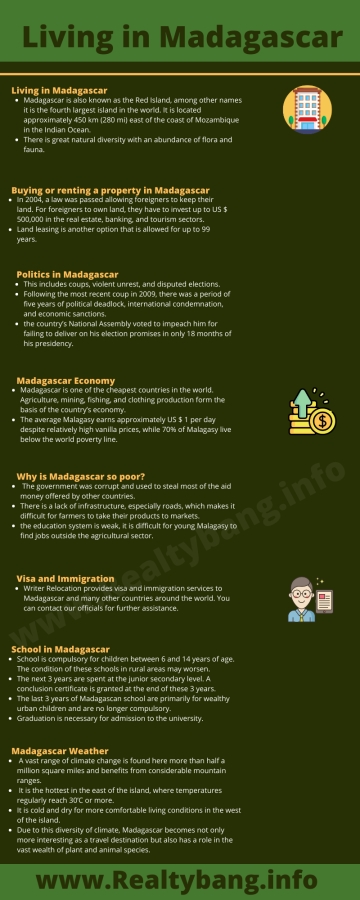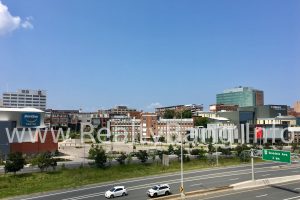Living in Madagascar: Madagascar is also known as the Red Island, among other names it is the fourth largest island in the world. It is located approximately 450 km (280 mi) east of the coast of Mozambique in the Indian Ocean.
It is an ideal place for nature lovers. There is great natural diversity with an abundance of flora and fauna. The landscapes are beautiful. The country’s ethnic diversity is reflected in its vibrant culture. Mastering French is a must for ex-pats who wish to live and work in Madagascar.
The people arrived before Borneo on the outrigger canoe in Madagascar between 350 BCE and 550 AD. Arabs, Indians and Chinese, and other groups settled in Madagascar over time, each making a permanent contribution to Malagasy cultural life.
Madagascar is included in the African Union. However, as recently as 2009 due to political turmoil about members of the African Union, its place is now being reconsidered.
Buying or renting a property in Madagascar
In 2004, a law was passed allowing foreigners to keep their land. For foreigners to own land, they have to invest up to US $ 500,000 in the real estate, banking, and tourism sectors. A one-stop office was created to assist foreign investors in those areas.
Land leasing is another option that is allowed for up to 99 years. Despite these fairly liberal policies due to bureaucratic constraints, foreigners still find it difficult to invest in the country.
Pure Malagasy and foreigners may have similar options. The first is a long strap. This is a very long-term rent of between 18 and 6 years and above. It almost feels like a purchase.
However, when it comes to the end of the agreement, all rights are reacted to the former owner. For the duration of the contract, the buyer had the right to sublet, construct and otherwise exploit the property.

Politics in Madagascar
This includes coups, violent unrest, and disputed elections. Following the most recent coup in 2009, there was a period of five years of political deadlock, international condemnation, and economic sanctions. After years of political instability in Madagascar, the election of Harry Rajonariampianina as President in 2013 brought new hope.
However, the country’s National Assembly voted to impeach him for failing to deliver on his election promises in only 18 months of his presidency. Although the vote failed, both supporters and opponents of Mr. Rajonarimapianina were faces to face.
Madagascar Economy and Living in Madagascar
Madagascar is one of the cheapest countries in the world. Agriculture, mining, fishing, and clothing production form the basis of the country’s economy. Vanilla is one of the most well-known products in Madagascar that comes from an orchid and is used for flavoring. The average Malagasy earns approximately US $ 1 per day despite relatively high vanilla prices, while 70% of Malagasy live below the world poverty line.
Why is Madagascar so poor?
There are several reasons. In the past, the government was corrupt and used to steal most of the aid money offered by other countries. There is a lack of infrastructure, especially roads, which makes it difficult for farmers to take their products to markets.
Madagascar’s geographical isolation from the rest of the world increases the cost of a trade. Whatever trade Madagascar does with other countries has to be shipped by boat or plane. Since the education system is weak, it is difficult for young Malagasy to find jobs outside the agricultural sector.
In addition, some people have access to technology or the Internet. Finally, environmental damage reduces the ability of Madagascar farmers decides Living in Madagascar to produce large quantities of food.
All is not lost, however. Madagascar announced that it had found large quantities of oil in 2005. Oil, gemstone production (Madagascar has a lot of sapphires), and tourism, along with mining, will be an important part of Madagascar’s economic future.
Visa and Immigration
Writer Relocation provides visa and immigration services to Madagascar, Africa and many other countries around the world. You can contact our officials for further assistance.
School in Madagascar
School is compulsory for children between 6 and 14 years of age. Primary schools are those where the first six years of it are spent. The condition of these schools in rural areas may worsen. All children have been prescribed a standard educational curriculum.
The next 3 years are spent at the junior secondary level. A conclusion certificate is granted at the end of these 3 years. This will be the end of school for many poor children who have managed to make it so far.
The last 3 years of Madagascan school are primarily for wealthy urban children and are no longer compulsory. Those completing the course receive a high school diploma – the equivalent of a bachelor’s. Graduation is necessary for admission to the university.
The university is the main parent institution in Antananarivo, which was established in 1961. This gave rise to other major tertiary institutions of the island nation.
Madagascar Weather
Madagascar offers a truly diverse climate. A vast range of climate change is found here more than half a million square miles and benefits from considerable mountain ranges. It is the hottest in the east of the island, where temperatures regularly reach 30’C or more. Brought by the trade winds of the Indian Ocean, the region also receives more rainfall.
It is cold and dry for more comfortable living conditions in the west of the island. You will find frost at higher altitudes, so it is possible to travel from “cold” to “tropical” in a single day. Due to this diversity of climate, Madagascar becomes not only more interesting as a travel destination but also has a role in the vast wealth of plant and animal species.
Madagascar typically experiences an annual cycle of hot and dry seasons, followed by a cool wet season, like many other equatorial regions.
Know the detailed information if you thinking about Living in Madagascar at https://en.wikipedia.org/wiki/Madagascar




